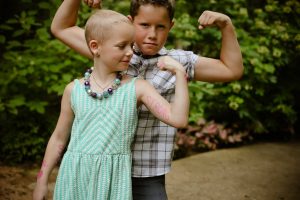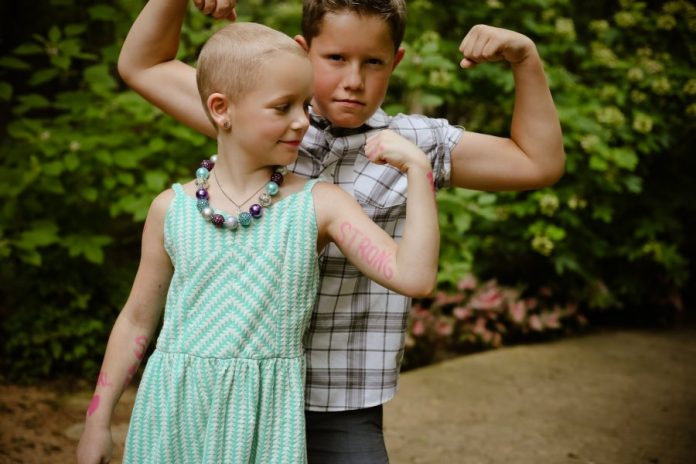
Sadie Keller, 8, of Lantana has an informational video on YouTube. Many young people have videos; but, none like Sadie’s. Her message to other children is what to expect from and how to live with cancer.
“She wants children to not be afraid and to know what to expect,” said her mother, Sarah Keller. “Sadie is a nervous child and had a hard time not knowing what was going to happen; if it was going to hurt, etc… so, she wanted to teach others what will happen so that they won’t have to be nervous if it happens to them.”
Last year, Sadie was a typical seven-year-old. She loved cooking, putting on makeup, playing soccer, drawing and playing with her friends.
In late 2014, she had visited her pediatrician with a few common illnesses– the flu, then strep throat, then some little tiny dots on her legs and stomach. With each illness she ran a low grade fever of 99.7 and was extremely lethargic. She had looked pale in January 2015; but, it was winter.
“After a long weekend with relatives, her grandparents thought she looked exceptionally pale,” said Keller. “Her aunt recommended that we take her in for blood work to test for Anemia.”
The following Monday—during an ice storm—her parents called her pediatrician to tell the doctor how pale Sadie was. She called the lab to do blood work the next day.
On Wednesday, Feb. 25, 2015 the Keller family’s lives changed.
The pediatrician called and asked to have Sadie and her parents come to her office. Sadie’s blood work results were back and something was wrong. She told them she’d be sending Sadie to Children’s Medical in Dallas after they met with her.
“I could barely breathe when I walked into the school to get Sadie,” said Keller. “I had no idea what it could be, but I knew it wasn’t good. I tried so hard to hold back my tears on our way to the pediatrician’s office. My husband, Shawn, met us there and we walked in together.”
Keller said she’ll never forget how the receptionist and nurse looked at them with complete sympathy. The family was shown into the doctor’s office.
“We got Sadie’s blood results back and they show that Sadie has Acute Lymphoblastic Leukemia,” said the pediatrician.
Sadie was sitting on her mother’s lap and whispered: “Mama, am I going to die?”
Childhood Acute Lymphoblastic Leukemia (ALL) is a type of cancer in which the bone marrow makes too many immature lymphocytes (a type of white blood cell).
According to Kidshealth.org, ALL is the most common type of childhood leukemia, affecting about 75-percent of children with this cancer of the blood cells. Kids ages two to eight are more likely to be affected, but all age groups can develop ALL. Thanks to advances in therapy and clinical trials, the outlook for kids with ALL is promising; with treatment, about 85-percent are cured.
The next stop for the family was to meet oncologist Dr. Tamra Slone. Keller said she’s since become like a member of their family. They also met Caitlin, the child life specialist at the clinic. She talked with Sadie and her healthy, 10-year-old brother, Grant, about what to expect having surgery to put in her port.
The next day Sadie had surgery for her port placement to receive chemotherapy and she also started chemo treatments orally.
The first week was rough. Sadie had so many side effects, including a reaction to the platelets that were given to her, as well as lots of pain in her legs and jaw plus very high blood pressure; which resulted in migraines.
After six-days in the hospital, Sadie was released to return home. She returned to the clinic two-days later for her first outpatient treatment and to have her port accessed.
The first phase of treatment, called Induction, continues for 29-days and reveals the risk level of the patient.
An odd thing happened following her first treatment; her port-side shoulder was raised up toward her ear.
“I can’t put my arm down,” she said, starting to panic.
They tried several different things to try to get her shoulder down, but it wouldn’t lower. Thinking it might be from having her port accessed for the first time, they called the clinic. They were told to watch it; wait and see.
The next day, Sadie was having some aches and pains from her treatment and her temperature was 99.6, which was higher than her normal, but not considered a fever in the oncology world.
When Dr. Slone called to tell them that Sadie’s cells had split the “good” way meaning that she was not at the Very High Risk level, Keller told Dr. Slone that Sadie’s temperature was elevated. The doctor said to watch it closely and call if it got above 100.5; which it did within 30-minutes.
Sadie was admitted back into the hospital and stayed for the remainder of the Induction time.
Subsequent tests revealed that Sadie had an E. coli bacteria in her blood stream which seemed to be in her shoulder and arm, close to her port. After a few days, many tests, MRI’s, doctors in and out, and visits with the infectious disease team, the infection had moved to her port.
Although the infection was treated with antibiotics, the decision was made to pull the port. She went into surgery to have her 12-day-old port removed; the following day, she had a second surgery to receive her PICC (peripherally inserted central) catheter line. This intravenous access tube is inserted above the elbow for prolonged chemotherapy regimens.
Because Sadie was on such strong chemo treatments, including steroids, the wound from her first port took eight-weeks to heal and close. They couldn’t close it since the infection was still there, so it was literally a hole in her chest. Each week, the staff had to replace the gauze and repack the wound—without a way to numb or prevent the pain.
Finally, by Day 29 of Induction, Sadie had reached the goal of remission. She was officially diagnosed as being Standard Risk B-Cell ALL. Her treatment plan will last two-and-a-half years.
The second phase of chemotherapy, Consolidation, typically lasts between one- to two-months and reduces the number of leukemia cells still in the body.
“Sadie did her first video on May 8th, when she was 2-1/2 months into her journey,” said Keller. “She was in the Consolidation phase of treatment. She did that video on her own, without her Dad and I knowing, from my closet. When she came out, she showed it to us.”
If the leukemia remains in remission after Induction and Consolidation, maintenance therapy can begin.
“She told us that she wanted to help other kids know that it doesn’t have to be scary and that when things are hard, you will get through them,” said Keller. “She also wants to teach other children what it is like for her in her words.”
Sadie is in this phase of treatment, called Delayed Intensification. During the first few months of maintenance, most treatment plans include one or two repeat intensified treatments, similar to the initial induction.
“We take everyday one by one and do our very best,” said Keller. “Shawn and I are so proud of Sadie and her positive outlook and smiles for days. She has inspired so many people through the Youtube videos she makes, sharing what it’s like for a child with cancer, and her strength and courage. She is our hero!”
To view Sadie’s YouTube video about what it means to be a child with cancer and to see more photos, click here.














 GIF.gif)


